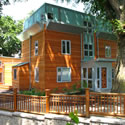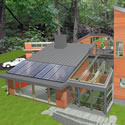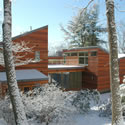|
Green
Design and Reconfiguring Tradition
Can
you talk about your green design and using copper and
other materials?
(BA): What
I have learned is that copper is one of the most sustainable
materials know to humankind. 80 percent of all copper
ever produced is in some form of use today.
It
makes the house more responsible. I've used sustainably harvested
red cedar and bamboo on nearly all my projects.
In
the case of the sod on the roof, did you bring that idea
to the client?
(BA): This
was the first house we did it on. Duncan brought it
up; he was thinking of doing it. We both researched
it.

Is
it a special type of grass?
(BA): Yes,
it is an energy sod product. I first discovered the
product manufactured by Toyota House, a new subsidiary
of Toyota that is getting into the industrialized housing
market. The grass is a special grain that is low maintenance,
needs to be cut a few times a year, light weight and
grows in the shade -- it's cool.
Duncan
sounds like a pretty enlightened builder. That is always
such a gift for an architect to collaborate with.
(BA): Yes,
Duncan is willing to take a risk, building something
that is forward-thinking. Duncan fits right in, young
guy, with young family that appreciates this type of
housing.
Is
there a market emerging yet for modern, progressive,
energy-efficient housing? Do you see it on the horizon?
(BA): Yes.
As for the horizon? Since the housing market is so
bad
right now it is hard to
say where we need to go from here, but I feel this
approach is best suited for moving forward.
 |
 |
 |
| Art
House combines red-cedar and copper (left) to form
new statement. A house in Weston, Mass., (middle and
right) was designed for the use of solar collectors
and capturing energy. Notice greenhouse section caught
between adjacent forms. |
I
think culture is still catching up with the idea of green
housing. America in particular is still struggling to
get rid of their eight-cylinder cars.
But
don't you think that the more society gets adjusted to
a more technological
way of living -- to save our planet, to save our resources
-- that domestic architecture will begin to reflect
that agenda, aesthetically?
(BA): I
think there is still some stigma attached to this
technology, like the stigma associated with collectors
on the roof. But there is some interesting stuff coming
out of Germany and elsewhere. Frank Gehry is covering
his buildings with interesting new technology. Some
of these new collectors are translucent, some become
screens. Some are now iridescent chips -- solar chips
-- that can cover the entire volume and can be made
to disappear or be celebrated.
Right,
high-profile architects like Gehry are key influencers..
(BA): If
this tech can be seen as cool ...maybe at some point
these collectors can be like iPods, where everyone
will want one. At the same time green does not always
mean seen. We are constantly looking for ways to build
responsibly.
Comfort
versus Responsibility
(AFR):
Speaking of iPods. They are so clearly modern and people
are so clearly comfortable with them. Why does domestic
modern architecture still struggle on this emotional
level? What is traditional architecture giving us --
most of us -- that modern architecture fails to provide?
(BA): That's
a great question. With architecture something happens
where there is an emotional charge. I think there is
fear of change, of the new. Architecture is used as
comfort. When architecture starts to change our world
starts to change. It is under-valued as a change unit.

Isn't
this just another way of saying our culture has a narrow
world view of what constitutes beauty? This is about
fear.
(BA): Most
people want architecture to be beautiful. In art, as
in other media, it is okay to be controversial. It
is okay to subvert and try to change. In art you can
look at the whole range of human experiences, from
those things that tear you apart and scare you to those
things that make life pleasant. But with architecture
you can't do that. You hide the underbelly of our human
nature, you protect it so that no one will ever see
it.
So
we have Katrina, we have dying polar bears, melting ice
caps, dangerous and erratic weather and death. But
you would never know it from the "comfort food" architecture
of Martha Stewartland. Don't architects
have real social responsibility here?
(BA): Of
course. Douglas Darden, a theoretical designer I greatly
respect, described the American experience as holding
the Sears catalog in one hand and the Old Testament
in the other. I think that's a great challenge to architecture,
to not only provide commodity but to respond to the
deeper human needs and experiences.
A
minute ago you spoke elegantly about comfort and architecture.
Comfort is a word you normally don't hear much in serious
architectural discourse. Perhaps because it is a word
that betrays our social responsibilities.
I
think we've reached the head of the problem here. How
do we reconcile our need for technology in architecture
to be "responsible" yet manage to keep domestic architecture
in particular, all about comfort, in the end expression?
(BA): I
think we must learn to get comfortable ourselves with
the technology first. Have you been to the Prada store?
In
New York? No.
(BA): It's
modern, it's techy and its cool. You watch people.
I like that because so much of architecture is given
away. So here is technology that says "come touch me,
talk to me, don't read that big sign, how does it feel?"
There
is a lot of discovery in that.
(BA): Absolutely.
That is the edge of technology for me that it can engage
you in a discussion. The architecture dialogues and
collaborates with you, rather than making everything
safe and signed out, accessible, so all is given away.
One
of the big changes coming with computer technology interfaces
is the tactile user interface, what is called the haptic
interface. We see with the Wii and we see it with the
iPhone. More of our body is interfacing with digital
technology now.
(BA): And
the technology can sense us. Now glass can sense us
and change from transparent to opaque in the dressing
rooms in a store. This is how technology in architecture
can change its perceived value for us, when it engages
with us, when it is proactive.
And
when it can help form that comfort.
(BA): Yes,
that's one opportunity. Let's
shift gears a bit because we are talking about stores.
Apple's stores
are hugely successful financially and its happening
at a design level. As an architect looking in, what is
working so well at Apple's stores?
(BA):
An Apple Store is graphic design with space wrapped
around it. It allows you to see the product. There
is not a lot of product, but a lot of repetition. You
would never see the same mannequin in Macy's with the
same outfit on repeated a dozen times in a row. At
the Apple Store the product has become the architecture.
One touches and experiments. You might call it a learning
laboratory.
next
page > | 1 | 2 | 3 | 4 |
Other Firm Profiles
Firm
Profile: Helsinki Architects Push BIM Agenda on Macs
Firm
Profile: Flansburgh Associates
Firm
Profile: LuminetIK
Firm
Profile: Of the Place Itself: A vernacular Modernism in
Austin |






![]()
![]()